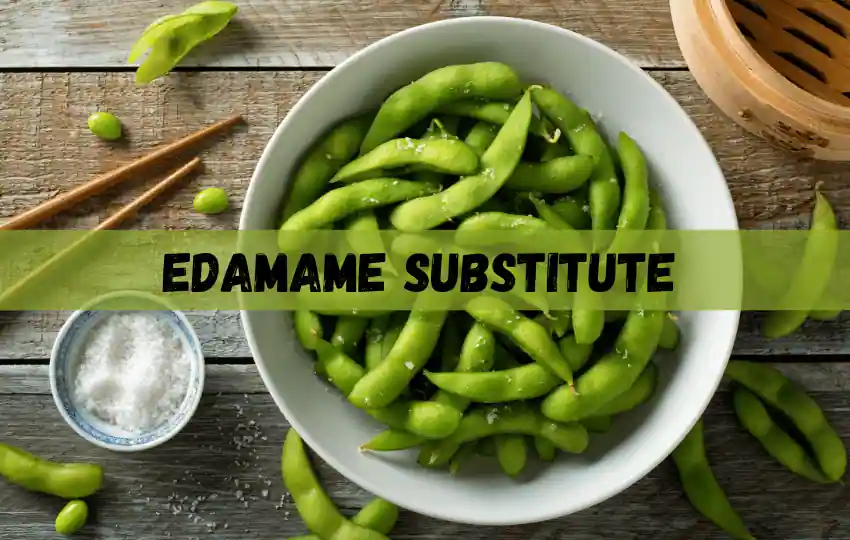Edamame is a popular snack among health enthusiasts because it’s high in protein, fiber, and essential nutrients. But what if you run out of this delicious and nutritious legume?
Or worse, you or someone you’re serving may be allergic to soybeans. Don’t despair. There are several edamame substitutes you can use in your recipes or as a snack.
In this blog post, we’ll introduce you to 17 quick and easy edamame substitutes, their unique features, and the measurement ratio to use.
So, let’s get started!
In short, "What can I use instead of edamame ?" Green peas, Chickpeas, Lima beans, Broad beans, Asparagus, Broccoli, Okra, Green beans, Snow peas, Soy nuts, Black Beans, Fava Beans, Lentils, Soy Nuts, Baked Tofu Cubes, Sesame Seeds, Almonds.
What is edamame, and what does edamame taste like?
Edamame is a type of green vegetable commonly consumed in Asian countries. It is immature soybeans harvested at the peak of their flavor and nutrition.
Edamame beans have a sweet, nutty flavor that can be enjoyed either cooked or raw.
They usually have a tender texture, although they can also become chewy when boiled or steamed for longer periods.
Served as an appetizer, side dish, or snack, edamame is high in protein and fiber while low in calories, making it a healthy addition to any meal.
What are the Uses of edamame?
Edamame is a delicious, nutritious snack and can be used in many different ways. They are taken raw as a snack or added to salads or stir-fries.
They can also be steamed or boiled and served hot with a variety of sauces such as teriyaki, soy sauce, garlic butter, or chili oil. Edamame can even be roasted for an extra crunchy texture.
They make a great addition to soups and stews, adding protein, fiber and flavor.
Edamame can also be pureed into dips and spreads, blended into smoothies, ground into flour for baking purposes or used as an ingredient in veggie burgers.
In Japan, it is common to add edamame to sushi rolls. Edamame is also gaining popularity in the United States as a popular substitute for traditional beans in recipes such as chili, burritos and tacos.
The possibilities are endless! So try adding edamame to your next meal and reap the health benefits!
Best edamame substitutes with measurement
1. Green peas
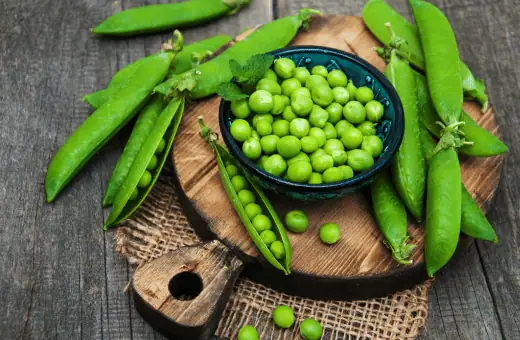
Green peas are among the closest substitutes for edamame in terms of taste and texture. They are low in fat and rich in fiber, vitamins, and minerals.
Ratio or measurement: To use them in recipes that call for edamame, use a 1:1 ratio. For instance, if a recipe calls for one cup of edamame, use one cup of green peas.
2. Chickpeas
Chickpeas, also known as garbanzo beans, are high in protein, fiber, and iron. Their taste and texture differ from edamame, but they are still a great substitute.
Ratio or measurement: To use chickpeas as a substitute for edamame, use a 1:1 or 1:2 ratio. For instance, if the recipe calls for one cup of edamame, use one cup of chickpeas or half a cup of chickpeas if you want a lighter substitution.
You can roast them, boil them, or make hummus with them.
3. Lima beans
Lima beans are a popular ingredient in bean salads and soups. They are low in fat and rich in protein, fiber, and iron.
Ratio or measurement: To use them as a substitute for edamame, use a 1:1 ratio or slightly more, depending on your preference.
Explore: Substitute for butter beans
4. Broad beans

Broad beans, or fava beans, are a staple in Mediterranean and Middle Eastern cuisine. They are low in fat and rich in protein, fiber, and vitamins.
Ratio or measurement: Use a 1:1 or 1:2 ratio, depending on the recipe and desired texture.
You can boil, roast, or puree them to use as a substitute for edamame.
5. Asparagus
Asparagus is another option for edamame substitutes. It’s low in calories and fiber and rich in vitamins and minerals.
Ratio or measurement: To use asparagus as a substitute for edamame, use a 1:1 ratio or slightly more.
Asparagus has a slightly different texture and taste than edamame, but it can still work well in your recipes.
6. Broccoli
Broccoli is a versatile vegetable that can mimic the texture of edamame when cooked correctly. It’s low in calories, rich in vitamins, and rich in fiber.
Ratio or measurement: Use a 1:1 ratio in your recipes, or serve it as a snack.
To use broccoli as a substitute for edamame, you’ll need to blanch it first, then season it with soy sauce and sesame oil.
7. Okra
Okra is a tropical vegetable that’s often used in stews and gumbo. It’s low in calories and fiber and rich in vitamins and minerals.
Ratio or measurement: Use a 1:1 ratio of roasted okra for edamame in your recipes, or serve it as a snack.
Okra has a slimy texture when raw, but you can roast it to remove the slime and add a crisp texture.
8. Green beans
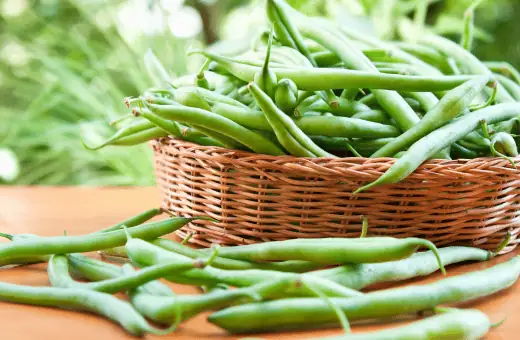
Ratio or measurement: Use a 1:1 or 1:2 ratio of green beans to edamame in your recipes, or serve them as a snack.
They have a different texture and taste than edamame, but they can still work as a substitute.
9. Snow peas
Snow peas are a type of pea that’s mostly eaten for their crunchy pods. They’re lower in calories, high in fiber, and rich in vitamins C and K. Snow peas have a different taste and texture than edamame, but they can still work as a substitute.
Ratio or measurement: Use a 1:1 or 1:2 ratio of snow peas to edamame in your recipes, or serve them as a snack.
10. Soy nuts
Soy nuts are made from roasted soybeans and have a crunchy texture and nutty taste. They are low in fat and rich in protein, fiber, and vitamins.
Ratio or measurement: Use a 1:1 ratio of soy nuts to edamame in your recipes, or serve them as a snack.
Soy nuts can be used as a substitute for edamame in recipes calling for roasted or boiled soybeans.
Discover: Delicious soy glaze alternatives
11. Black Beans
Black beans are a great replication for edamame if you want to mix it up and add some color to your dishes.
They are packed with protein, fiber, and iron and have a firm texture.
Ratio or measurement: The best ratio is usually one cup of black beans for every cup of edamame.
You can use them in salads or roasted as a snack.
12. Fava Beans
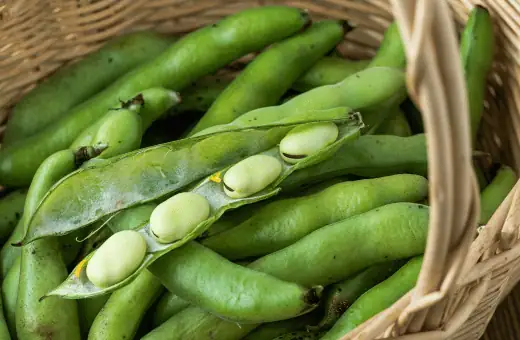
Fava beans are one of the most nutritious beans out there, and they make an excellent edamame substitute.
They have a nutty flavor and a firm texture that are perfect for snacking or mixing into salads.
Ratio or measurement: For every cup of edamame, use one cup of fava beans.
To cook them, simply boil them in salted water for 10-15 minutes until they are tender.
13. Lentils
Lentils are a wonderful alternative to edamame because they are high in protein, fiber, and iron.
Ratio or measurement: The best ratio is usually one cup of lentils for every cup of edamame.
You can use them in salads, soups, or roasted as a snack.
14. Soy Nuts
Soy nuts are another option for those who want a quick and easy edamame substitute. They have a similar texture and flavor but are much crunchier.
Ratio or measurement: The best ratio is usually one cup of soy nuts for every cup of edamame.
Simply roast them in the oven with a little bit of salt and olive oil.
15. Baked Tofu Cubes
Baking tofu cubes in the oven can make them crispy and crunchy, making them an ideal edamame replacement.
Ratio or measurement: The best ratio is usually one cup of baked tofu cubes for every cup of edamame.
You can season them to your taste and use them in salads or as a snack.
16. Sesame Seeds
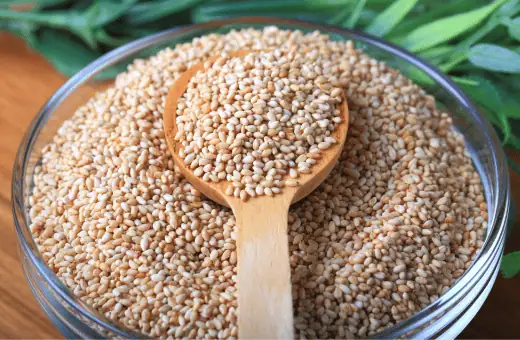
Sesame seeds are a great substitute for edamame if you want a crunchy, nutty flavor. You can sprinkle them on top of salads or use them as a seasoning for roasted vegetables.
Ratio or measurement: The best ratio is usually one tablespoon of sesame seeds for every cup of edamame.
17. Almonds
Almonds are a terrific substitute for edamame if you are looking for a crunchy and nutty snack. They are rich in protein and healthy fats and can be roasted with a little bit of salt or seasoning.
Ratio or measurement: The best ratio is usually one cup of almonds for every cup of edamame.
Difference between broad beans and edamame
Broad beans are a type of cool-weather legume. They have large, flat pods and can be harvested in their immature or mature state.
Immature broad beans have tender, edible pods and soft, starchy seeds with flavors ranging from mild to nutty.
Edamame is immature soybeans that are harvested before they harden and have a sweet, earthy taste with a crunchy texture when cooked.
The main difference between broad beans and edamame is the plant they come from – broad beans come from the Vicia faba family, while edamame comes from the genus Glycine max (soybean).
Broad bean pods will contain either light green to white colored beans inside, while edamame will be darker in color.
Also, broad bean seeds can vary in size but tend to be larger than those of an edamame bean pod.
Additionally, because of its low glycemic index content compared to other foods with carbohydrates (less glucose released into the bloodstream), it makes it beneficial for diabetics.
Broad beans are a great source of protein, dietary fiber, vitamins and minerals such as folate, iron, magnesium and potassium.
Additionally, consuming broad beans has been linked to numerous health benefits, including improved heart health, better digestion and weight management.
They can be enjoyed cooked or raw in salads and stir-fries. With their unique flavor profile, these unique legumes are sure to become a favorite addition to your diet!
Frozen edamame beans substitute
Frozen edamame beans are a great substitution for more traditional green vegetables. They have a mild yet slightly sweet flavor and can be added to salads, stir-fries, casseroles, soups and more.
High in protein, vitamins and minerals like iron, calcium and fiber, edamame beans are a nutritional powerhouse that is low in fat and calories.
Frozen edamame beans can easily be replaced with shelled green peas.
Peas are nutritious legumes that are packed with vitamins and minerals like vitamin A, folate, manganese and dietary fiber.
They have a sweet, earthy flavor that makes them versatile for a variety of dishes, from salads to side dishes to entrees.
Shelled frozen peas are an excellent alternative to edamame as they can be cooked quickly and do not require any special preparation except for a light rinsing before cooking.
For a healthy and balanced meal, try combining frozen peas with other legumes like lentils or chickpeas for an easy vegan dish.
To add extra flavor to your meals, stir-fry the peas with onions and garlic before adding them to your dish. Enjoy!
Where to buy edamame?
If you are searching for where to buy edamame, there are a few different places you can go. Many specialty food stores carry it, as do some international grocery stores.
You can also order online from many retailers that provide a variety of diverse flavors and types of edamame.
Conclusion on edamame substitute
In conclusion, running out of edamame doesn’t have to ruin your recipe or snack time. There are 17 readily available edamame substitutes that you can use.
The preparation method and ratio vary, but they’re generally easy to use.
You can experiment with different substitutes to discover the one that fits best for you or your recipe.
Always remember the substitutes’ nutritional benefits and potential allergens when serving.
So next time you run out of edamame, don’t panic. Just use one of these substitutes and enjoy the deliciousness and nutrition.
FAQs on edamame substitute
Q1. What is the same as edamame?
Edamame is a type of vegetable similar to green beans and peas. Other vegetables that are similar to edamame include snow peas, sugar snap peas, soybeans, and mung beans. All of these vegetables can be cooked in the same way as edamame and can also be used in similar dishes.
When cooked, edamame has a mild flavor and makes a delicious side dish or snack. It can also be added to soups, salads, stir-fries, curries, and more for extra flavor and nutrition.
As with all vegetables, edamame is low in calories but high in fiber and other essential nutrients like vitamins A, C, E, K, B6, folate and magnesium. Eating edamame may help boost your energy levels while providing your body with essential nutrients.
Additionally, it may aid digestion and reduce blood sugar levels due to its high fiber content. For these reasons, edamame makes a tasty addition to any meal!
Q2. Can you replace peas with edamame?
Yes, you can! Edamame is a great alternative to peas in many dishes. They have a slightly different flavor and texture than traditional green peas, but they are packed with protein, fiber, vitamins and minerals that make them an ideal substitute.
Just remember to cook edamame according to the package instructions before adding them to your dish. Enjoy!
Q3. What is an Indian substitute for edamame?
One Indian substitute for edamame is mocha or field beans. Mochai, also known as cowpeas, have a similar mild flavor and crunchy texture to edamame. They are cooked in the same way as edamame – boiled, steamed, and salt – but may need to be soaked overnight before cooking.
Field beans can also be cooked with spices such as turmeric and cumin for added flavor. Other substitutes for edamame include green peas, lima beans, black-eyed peas, and fava beans. All of these offer a tasty alternative to traditional edamame recipes.
Q4. Are edamame and green peas the same?
No, edamame and green peas are not the same. Edamame is a kind of immature soybean that is harvested before it can fully ripen and harden into a mature bean. Green peas are a different species from edamame and are picked when they are mature and ready to eat.
The most notable difference between them is their taste: edamame has a nutty flavor with a hint of sweetness, while green peas have a grassy, earthy taste. In terms of nutrition, both offer an impressive amount of protein, fiber, vitamins, minerals, and antioxidants.
However, the nutrient content varies slightly between the two due to their different growing cycles. For example, edamame contains more fat than green peas. Overall, both are excellent sources of nutrition and can be relished as part of a healthy diet.
Q5. Can you use soya beans instead of edamame?
Yes, you can use soya beans instead of edamame. However, you should note that soya beans are typically larger in size than edamame and have a firmer texture when cooked. Additionally, because of their size, they may take longer to cook than edamame.
You’ll also want to adjust the amount of cooking liquid used for the recipe since the larger size of soya beans will require more liquid for optimal flavor.
Lastly, if using dried or canned soya beans for your recipe rather than fresh ones, make sure to check the instructions on the packaging, as different brands may vary in preparation instructions.
With these considerations in mind, you should be able to successfully substitute soya beans for edamame in your recipe. Enjoy!
Q6. What is the closest vegetable to edamame?
The closest vegetable to edamame is green soybeans. These are immature, unripe, green pods of the soybean plant which have not yet developed into their mature form. They are harvested while they are still young and tender and are often used in stir-fries or salads.
Green soybeans have a similar flavor to edamame but with a slightly sweet nuttiness.
The texture is also very similar – crunchy with a soft center when cooked. Green soybeans offer some of the same health benefits as edamame – such as being high in protein, fiber, minerals and vitamins – making them an excellent source of nutrition.
Q7. Can you substitute lima beans for edamame?
Yes, lima beans can be used as a substitute for edamame. They have similar nutritional benefits and can easily be cooked in the same way as edamame. Lima beans are also lower in calories than edamame, so they may be a better choice for those watching their calorie intake.
However, it should be noted that lima beans have a slightly distinct taste and texture than edamame, so the dish may not come out exactly the same. Additionally, some recipes call for specific ingredients like shelled edamame which cannot be substituted with lima beans.
In these cases, other substitutes, such as green peas or broad beans, could work instead of edamame. Ultimately, it is up to personal choice to decide whether or not to substitute lima beans for edamame.
Q8. Can you substitute edamame for snow peas?
Yes, you can use edamame as a substitute for snow peas. Edamame is young soybeans that have been harvested before they harden and turn yellow. They come in both shelled and unshelled varieties and have an earthy flavor similar to snow peas.
Edamame can be steamed, boiled, or stir-fried like snow peas or used raw in salads and other dishes. If you’re looking for a vegan or vegetarian alternative to snow peas, edamame is a great choice!
Q9. Can you substitute edamame for broad beans?
Yes, you can substitute edamame for broad beans in many recipes. Edamame is a delicious and nutritious alternative to broad beans. It has a slightly sweet taste that is similar to the taste of broad beans, and it provides the same vitamins and minerals as well.
Furthermore, edamame is much easier to prepare than broad beans, making it a convenient option for quick meals and snacks. When substituting edamame for broad beans in recipes, remember to adjust the amount of salt or other seasonings accordingly. Enjoy!

